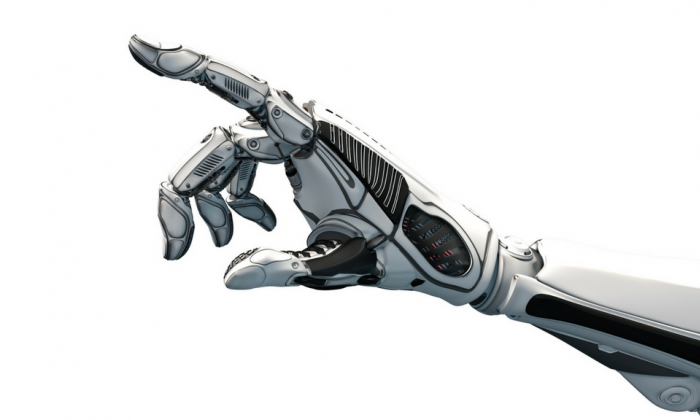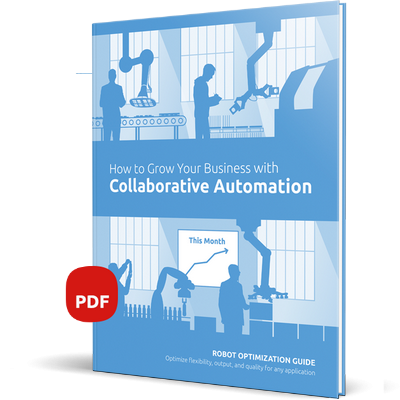Intelligent automation: How sensors and software make robots smart


To grant competitive advantages, industrial robots must become sensitive and smart. This is where sensors and software come in: Equipped with these, collaborative applications widen the scope of automation.
When the first industrial robots entered the factory halls, their advantages were primarily characterized by force: With increased working speed and precise repeatability, they could easily handle huge payloads. Correspondingly, the first industry to use them large-scale was automotive manufacturing, where robot arms performed basic tasks such as picking and placing heavy parts.
Nowadays however, demands have changed:
- Globalized market environments put manufacturers under pressure to react fast and flexible to their volatile conditions.
- Individualized customer requests and lot sizes of one make production a complex undertaking.
- A shortage of qualified workers makes it hard for companies to handle their orders or even forces them to decline, preventing them from growing.
These challenges make it inevitable for manufacturing companies to rethink their production ways.
At this point, the idea of collaborative robotics comes in: Robots and humans start working side by side, with the machines relieving workers from strenuous tasks and granting support just where it is needed.
However, to safely work next to humans, robots need to adapt: They must be able to see, feel and think. Only equipped with these skills can they comprehensively provide manufacturers with the benefits of automation, leaving the fences behind.
Collaborative robots: sensors make it possible
To acquire human-like capabilities, robots need to be fitted with the right sensors. Proximity and thermal sensors, force / torque and optical sensors enable a robot arm to perceive relevant variables like distance, force or speed. With their help, robots can control their force and apply it in a considerate way. Thus, they can react to their surroundings immediately and perceive human touch.
- This makes it safe for humans to work alongside robots, as they perceive their presence and adapt their own movements if necessary.
- Furthermore, providing robots with a sense of touch makes new application scenarios conceivable: Equipped with sensors, robots can perform complex tasks such as quality control, circuit bord assembly or polishing, increasing the economic benefits of automation.
The Polyskin Tactile Gripper for example has integrated tactile sensors at the tips of its two, individually actuated fingers. They enable it to provide accurate position-orientation and force data, making it possible to assess the grip quality. Thus, the gripper can handle even delicate items precisely and prevent dropping.
Adding intelligence: Smart robots automate more
However, to live up to the potential of automation, robots not only need senses, but they also need intelligence.
To make a robot smart, it takes the right software. OnRobot products are equipped with software packages that make them capable of performing complex tasks.
- The RG2-FT Smart Gripper is a truly intelligent gripper: It has both force-controlled insertion software as well as force/torque sensors and a proximity sensor integrated in its fingertips. Thus, it can see, feel and command its own movements. On this basis, the gripper can perform highly precise machine tending and assembly tasks.
- The HEX Force / Torque Sensors come with a comprehensive software package. Thanks to this, users can teach robot arms complex paths. Moreover, the arm is enabled to constantly keep the same force and speed and can thus perform highly precise tasks of surface finishing like polishing or deburring.
Furthermore, the pre-programmed software packages make the applications’ setup easier and enable users to perceive the advantages of automation faster. Their intuitive user interface adds to the same idea.
Software and sensors: maximizing the benefits of automation
To get the most out of automation, robots therefore need senses and brain. This is where automation becomes sensitive and intelligent. Only at this level do manufacturers benefit from advantages like increased process efficiency, short integration time and fast return on invest. In the end, only the application as a whole makes a difference.

|
Cách phát triển doanh nghiệp của bạn với các ứng dụng cộng tác
Với sự khởi đầu của công cụ thông minh hơn và có khả năng thích ứng cao hơn, giờ đây rô-bốt có thể hoạt động với tốc độ, sức mạnh, sự an toàn và độ chính xác cao hơn, hoàn thành một loạt các nhiệm vụ trong khi vẫn tối đa hóa ROI. Tìm hiểu thêm về cách bạn có thể cho phép sản xuất nhanh hơn với chi phí thấp hơn bằng cách tải sách điện tử miễn phí của chúng tôi về.
NHẬN SÁCH ĐIỆN TỬ MIỄN PHÍ
|

|

